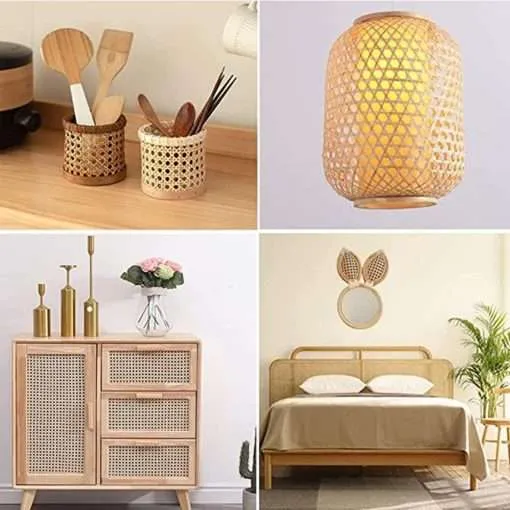Antique restoration and modern crafting both require incorporating rattan furniture, and every home needs this sophistication and elegance. Novice and seasoned weavers alike struggle with the variety of options available on the market, and choosing the right rattan cane furniture can be rather tedious. To ensure aspiring furniture weavers make the most out of their projects, and achieve stunning beauty along with unparalleled durability, this guide was created.
Understanding The Types Of Rattan Cane
Strand Cane: Best suited for hand weaving of traditional patterns on chair seats and backs, strand cane comes in coils. This specific strand cane can execute intricate designs and give the desired detail along with classic appeal.
– Pre-Woven Cane Webbing: First time users, or those with time constraints, should use this. This strip of cane makes the weaving process easier because it is already woven into sheets that can be used for big areas.- Flat Oval Reed: This type of reed is wider and good for covering more space. It is used for weaving baskets or creating decorative elements on furniture.
The pre-woven webbing or stem cane has a smooth finish and a soft texture, so it is suitable for beginners and advanced users alike. These materials can be purchased from Cane Weaving Supplies.

Picking the Right Size and Gauge
A room’s furnishings and decor are crafted to accommodate a certain gauge (thickness) of the rattan cane. Gauges can be defined as follows:
– Fine Gauge (2.0 – 2.5mm): Best applied for the detailed construction and intricate weaving of delicate furniture pieces.
– Medium Gauge (2.75 – 3.5mm): Used in almost every furniture repair and restoration task, this is the most common size ideal for starters.
– Coarse Gauge (4.0mm and above): A more solid construction is required. Suitable for rustic or strong furniture pieces that need more aggressive weaving.
Because of its flexibility and ease of handling design. Medium gauge cane is a suitable match for most weaving projects. Cane Webbing Supplies offers furniture weavers a wide range of different gauge sizes suitable for all skill levels from beginner to expert.
Checking The Quality Of The Cane
To avoid facing problems while weaving furniture, a good quality cane must have the following properties:
– No dark patches throughout along with consistent color distribution.
– A smooth yet strong skin without sections that break easily into brittle pieces.
– The diameter must remain uniform all over the coil/sheet. Enhancing a project could be simpler than it appears with better quality materials. The increased durability, aesthetic value, and life span of the project can surely outweigh a few extra dollars put on high grade cane. Not every manufacturer prioritizes quality, which is why every weaver’s preference is to ensure that each batch of cane weaving supplies goes through inherent verification procedures.
Principles of Conditioning Your Rattan Cane
Weaving requires prior conditioning in order to ensure the highest care standards are met. Follow these instructions:
– Soaking: Soak your cane in a heated body of water for 15-30 minutes or until flexible. Soaking it extensively will weaken fibers and avoid being soaked too long.
– Draining: The cane requires gentle shaking in order to remove excess water. Soaking needs to be at a pliable but not too soft stage for dripping to take place.
Conditioning makes it easy to ensure that there are cracks or repairs that need to be done resulting in piece of conditioned cane devoid of any repairs.
Starting Your Weaving Project
This is the section tailored for you if you are looking to learn about furniture weaving for the first time. It is the part you need to start your project.
This guide will take you through the steps of cane weaving in an easy manner that is simple to understand.
- Prepare the Piece of Furniture You Will Work With: Make the joins and edges of all surfaces that require cane bits to sparkle with the aid of a knife. Scrape all the smooth surfaces of the furniture and polish them. Clean all else and polish every surface.
- Hold the webbing in place using weaving pegs until the glue dries for the pre-woven cane: Utilize the pegs for holding the webbing in place until the adhesive sets or until the glue dries.
- Use Consistent Care Weaving Strain with Every Single Strand of Cane: Each movement while weaving has to be identical, if there is no tension, or the weave will warp.
- Weaving is complete when the cane gets trimmed to achieve an elegant finish by sharp conspicuous cutters: Weaving cutting.
- If there is finishing of any sort such as spline, ensure to properly secure them in place for the cane weave to maintain it’s strength and durability for years down the line: Final installation.
For an all-inclusive guide, Cane Weaving Supplies are ideal. They have premium crafting supplies and offer uncomplicated step by step guides along with videos and kits that make crafting simple.
Guidelines for achieving maximum results in craftsmanship include:
– Start with Projects of Moderate Difficulty First: Building a whole piece of furniture might be difficult for you at the beginning. You can gain confidence by completing smaller projects and working your way up from there.
– Wrap with Constant Weaving Tension: The tension during the weave has to be uniform throughout the width of the piece for it to be visually appealing and strong.
– Share Ideas with Other Weaving Enthusiasts: Solving problems and sharing ideas with others in local classes or on internet forums can help improve your overall experience with weaving.
Get ready for the challenges that come with furniture weaving
Cane weaving is an art that is easy to learn as long as the selection and oversight processes are done right. Making furniture pieces you can be proud of starts with making the right choice of rattan cane.
Ready to take on the challenge of weaving? Pickup premium quality rattan Cain and other tools intended to enhance your furniture weaving experience at Cane Weaving Supplies today.

